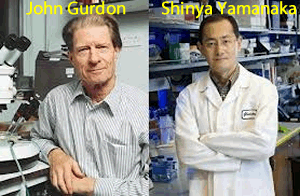Embryonic stem cells from mature cells
Now researchers are able to develop stem cells that behave like embryonic stem cells, that is, they keep dividing and can form a range of specialised cell types using normal adult cells (like skin cells).
In 2012 John Gurdon and Shinya Yamanaka won the Nobel Prize for their work in reprogramming adult cells back into stem cells.
John Gurdon of the Gurdon Institute in Cambridge and Shinya Yamanaka of Kyoto University, discovered ways to create tissue that would act like embryonic cells, without the need to collect the cells from embryos.
Gurdon and Yamanaka have shown that specialised cells can turn back the developmental clock under certain circumstances.

One way of doing this is to insert the nucleus from an adult cell into an egg that has had its nucleus removed. This is known as somatic cell nuclear transfer, as shown on the right.
The egg now develops into an embryo with embryonic stem cells that are perfectly matched to the adult cell donor.
Yet another technique does away with eggs altogether and works by reprograming the genetic material of adult cells to behave like embryonic stem cells (induced pluripotent stem cells). Click for more information on controlling genes.
Both technologies have only recently been used to produce human cells and will need extensive research before they can be used therapeutically.
